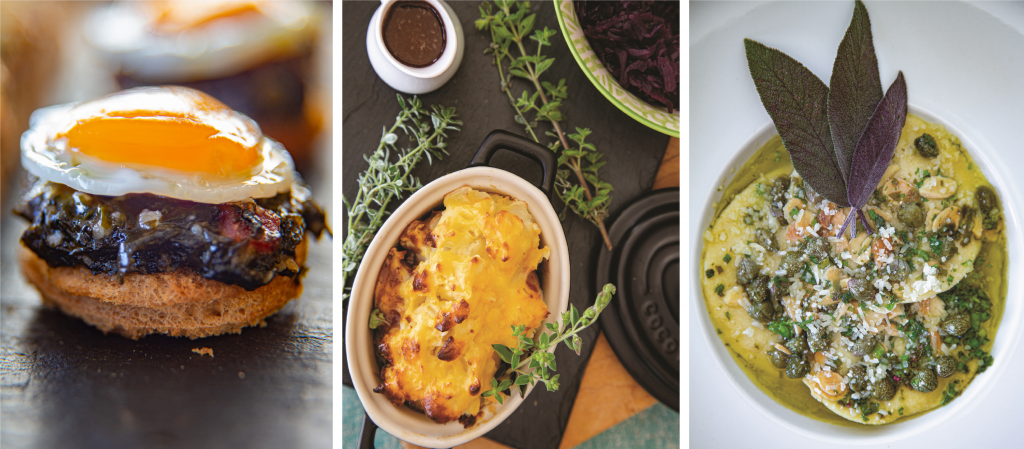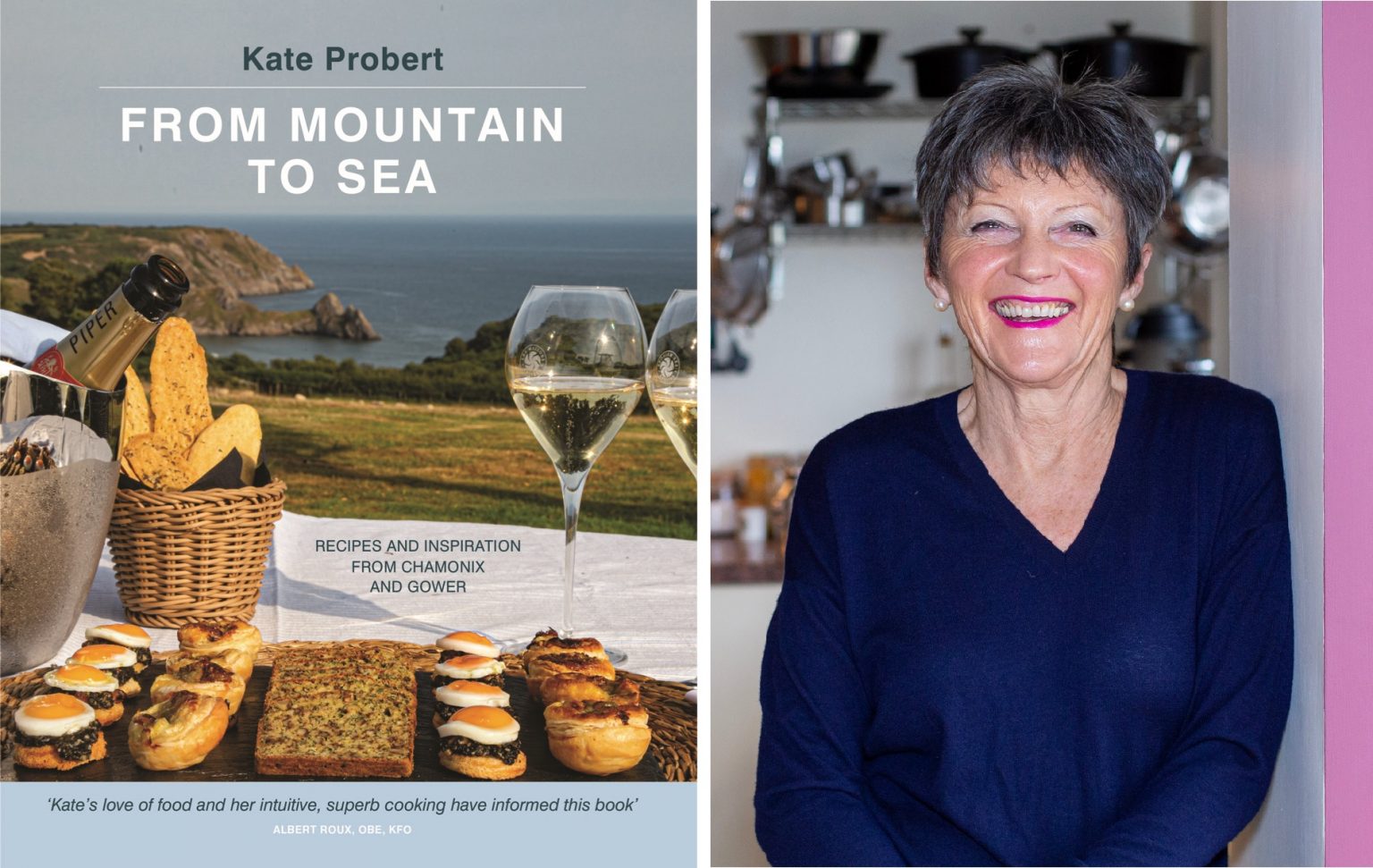Welsh chef Kate Probert, who runs a cookery school in Gower and previously won guidebook recognition for two much-loved Welsh restaurants, has released her first book. From Mountain to Sea is a perfect Christmas present for any Francophile or food lover. It contains a beautiful collection of French-inspired recipes, interspersed with stories of Kate’s life in the UK and France, where she and her husband owned a mountain chalet until recently. The book can be purchased here: https://www.lamusechezkate.com/from-mountain-to-sea
Here are some perfect examples of winter dishes from Kate’s book:

Welsh breakfast canapes
I make these frequently in France as I love to show off this wonderful ingredient known as laverbread. I buy my laverbread in Swansea market fresh, then freeze it into smaller portions and use it for all sorts of recipes. However, the tinned product is also very good and handy to have in my cupboard in France. I would serve these at room temperature rather than at the last minute as that would be too fiddly. Make the laverbread mix and cook the eggs up to 1 hour before. I recommend you assemble them just before your guests arrive.
Take a whole loaf for this and make croûtons out of all of it. They will last for ages in an airtight container and the croutons can be used as bases for other mixtures.
MAKES 12
Oven: 160°C/gas mark 4
For the “fried bread”:
12 croûtons from a sliced loaf
For the mix:
75 g laverbread mixed with 2 teaspoons oatmeal
50 g diced Welsh bacon or pancetta
12 quail eggs
1 tablespoon olive oil
1 teaspoon vinegar
some cockles (optional)
- Cut out rounds from a medium sliced loaf with a 3.5/4 cm diameter cutter.
- Put onto a baking tray and brush with oil.
- Cook in the oven until completely dried out and slightly brown (about 20 minutes).
- Store in an airtight container until ready to use.
- Fry off the bacon and add the laverbread, oatmeal, vinegar and cockles if using. Season.
- For the fried eggs: break all the eggs carefully into a bowl together and, in a small non-stick pan, heat up the olive oil. When hot, but not smoking (we don’t want crinkly eggs!), pour in all the eggs and with a non-stick, heatproof spatula, quickly separate the yolks so that they aren’t touching each-other. When the white is firm and the yolks are still runny, slide the whole lot out onto a board and cut around each yolk with the same cutter you used for the croûtons to make a small fried egg. Eat the rest of the white in a sandwich or give it to the dog!
- When ready to serve, cover each croûton with the laverbread mixture and top each one with the egg. I used to warm up the mixture on the croûton, but they are delicious as they are so I don’t bother any more.
Easy? Yes
Quick to make? Yes
Make ahead? Yes
Freezable? The mixture, yes. The croûtons, no need. The eggs, no
Butternut squash ravioli
I came across this recipe when I was spending a year in Bergamo. I saw it being prepared on Italian TV. Now, that was a challenge for me in my early days of speaking Italian! One can find this recipe throughout Italy and its diverse regions, each of which has its own slight variation which makes the recipe unique to that region. This one is from Brescia in Lombardy, where they add amoretti biscuits, but I found it a little too sweet – especially as butternut squash is quite a sweet vegetable in itself. I substitute the biscuits with breadcrumbs so as to absorb any excess moisture from the mixture. It works very well and the consistency is perfect.
MAKES ABOUT 21 RAVIOLI
Pasta dough:
300 g flour type 00
3 eggs
drizzle of olive oil
salt
For the filling:
300 g squash
sprig of rosemary/sage
1 bay leaf
1 large shallot, chopped
1 garlic clove, crushed
50 g parmesan, grated
100 g goats’ cheese
50 g fresh breadcrumbs
olive oil
1 egg, beaten
For the sauce:
large knob of butter
about 1 tablespoon capers and some of their juice
juice of a lemon
sliced almonds
grated parmesan
chopped parsley
- Make the dough by putting into the food processor and whizzing to a ball.
- Cover with cling film and refrigerate.
- Cut the squash into small chunks and fry off gently with chopped rosemary, shallots, bay leaf and seasoning. Add a small drop of water then cover and stew until tender.
- Take off the lid and boil hard until all the liquid has evaporated.
- When the mixture is cold, add the breadcrumbs, parmesan and goat’s cheese. Check for seasoning.
- Cut the dough into 8 segments and roll out each segment of dough in the pasta machine, starting on the widest setting and re-rolling until you have come to the finest setting. Lay out on the table and egg wash 4 of the strips of pasta and then place a spoonful of the mixture, equally spaced. Then place the pieces without egg wash on top.
- Press around each mound in order for the pasta to stick and then cut out rounds with a cutter, or cut into squares. Go around each one again with your fingers and then place on a tray lined with a tea towel.
- At this point, freeze them making sure they aren’t touching each other. When frozen, remove from the tray and put into containers.
- Melt the butter in a large frying pan and add the almonds to brown a little, then the capers and lemon.
- Put a large pan of water on to heat and, before it comes to the boil, add the frozen ravioli, bring back to the boil and cook for about 2 minutes.
- Drain and add to the frying pan to coat. Sprinkle with parmesan and serve.
Easy? Fairly
Quick to make? No
Make ahead? Yes
Freezable? Definitely!
Wine suggestion: Chassagne-Montrachet blanc
Venison Parmentier with parsnip purée
Antoine-Augustin Parmentier (1737 – 1813) declared that potatoes were edible in France in 1772
I first made this dish for Geraint, who came up to practice our piano duets. I asked him to stay for supper and when I served the parmentier, he exclaimed, ‘Wow, is this what you call a Monday night supper?’ It can be done well in advance so great for a crowd. Just pop it in the oven before you clear the starters. I have used parsnip here to make the dish a little lighter. Anyway, parsnip goes very well with venison.
SERVES 6
Oven: 140°C/gas mark 3
900 g mixed, diced game or venison
2 carrots, roughly chopped
1 large onion, roughly chopped
1 tablespoon chopped ginger
1 bay leaf
2 teaspoons tomato purée
20 or so juniper berries, slightly crushed
1 bay leaf
thyme
salt and pepper
1 bottle red wine
1 chicken stock cube
2 tablespoons olive oil
½ tablespoon flour
675 g parsnips
675 g potatoes
a little milk and butter
- Dry off the meat with kitchen towel.
- Heat the oil in a casserole pan and fry off the meat and vegetables until starting to take on some colour.
- Add the flour to coat and cook for a minute or two, then add the wine and the rest of the ingredients.
- Top up with water, add the stock cube and bring to the boil gently. Put the pan into the oven and cook for 2 hours and leave to cool in the liquid. If you have the time, leave overnight for the flavours to develop.
- Strain the meat and reserve the juice. Remove the bay leaf and put it all in a food processor with the vegetables. Moisten with some of the cooking juices (keep the rest for serving).
- Whizz but not too much – you don’t want the mixture to be smooth, but nice and chunky.
- Make a purée with parsnips and potato: cut into chunks and cook in boiling salted water until just cooked. Drain and put back on the heat for a few minutes to dry, add a little milk, heat it up, then mash with a knob of butter.
- Serve the parmentier in individual dishes or by using cheffy rings and top with the mash.
- Brush with beaten egg and heat in a medium oven until golden.
- Serve with the sauce around the parmentier and with a spoonful of red cabbage, creamy sprouts or other greens.
Easy? Yes
Quick to make? Not very
Make ahead? Yes
Freezable? Yes
Wine suggestion: Barolo



